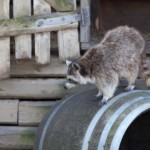
Raccoons are a big problem on Long Island, and we receive a lot of calls to control the issue. If you find yourself with a raccoon problem, safe and timely raccoon removal is important.
Raccoons are a threat to you, your family, and your pets when they are allowed to live in an attic or chimney. Aside from doing structural damage to the home, raccoons can also carry rabies, distemper, and a deadly roundworm parasite (Baylisascaris procyonis), so it’s important to remove this wildlife as soon as its presence is detected. T If you have found that raccoons have taken up residence in your home, there are several steps you can take to get them out safely and permanently.
So You Have a Raccoon Problem Outdoors… 
First, it’s important to understand what raccoons eat…everything! They are omnivores, meaning they eat both animals and plants, though they’ll eat pretty much everything you have to offer.
Raccoons are often found raiding chicken coops and eating the eggs after killing the fowls. They will also break into food stores on many occasions. Most of our calls, however, consist of raccoons in garbage cans. For this, it’s important to keep cans sealed and sturdy. Keep them clean.
While raccoons are easily trapped, they are also territorial animals. Therefore, after one raccoon is extracted, another will just take its place. When feeding babies or young kits (baby raccoons), adult raccoons will defend them ferociously—and sometimes even attack people who get too close. If one or more kits have been separated from their mother during this process and are still nursing, she will likely come back to find them in order to continue providing milk for them until they’ve grown big enough to start eating solid foods on their own.
This is where a professional exterminator can help – they know how to keep all pests away after getting rid of the current ones.
What to Do If You Get a Raccoon in the House
Raccoons indoors are a bit more challenging to deal with. They’re very intelligent, which means they can open latches, doors, and other objects meant to keep them out of your home! They can be found in any rooms of unoccupied buildings, wall spaces, chimneys, or attics. In fact, a raccoon only needs a hole with a two-inch radius to climb through. Also, you should investigate if you hear chirping sounds (which is a sign of young raccoons) or screaming/crying (which is a sign of raccoon mating).
Raccoons are very intelligent and they can be persistent when they want to get into your home. If you remove a raccoon before identifying and sealing all entry points, the raccoon will find another way in. It may take some time, but it will happen.
Raccoons are good at finding new entry points because they are natural explorers and love to explore new areas with their families. They’ll also try to sneak back into your home if they feel threatened by a cat or dog patrolling the property outside (or even inside). Raccoon kits often follow their mothers in order to learn about new surroundings and discover food sources for themselves as adults someday soon.
Identifying Raccoon Entry Holes is Key
Raccoons often enter Long Island homes through the roof. They can also crawl through soffits (the space above exterior walls) and gutter pipes. To prevent this, installing flashing along your roof line, repairing or replacing damaged shingles and flashing, and installing a chimney cap can help. They’ll also enter a home through the attic through an opening near vents or light fixtures, or they may climb up to an opening at the eaves of your home using tree limbs as support. You can stop this problem by sealing all possible openings between floors with wire mesh hardware cloth. Keep in mind that raccoons are very intelligent and dextrous!
How to Remove a Raccoon from Your Home
People often assume wildlife control and pest control are synonymous; however, in many states, different licenses are required because the treatment is so different. To relocate an animal, permission from the state’s gaming department is almost always needed, usually in writing. Furthermore, before relocation can occur, the animal needs to be trapped (very different from exterminated). Exterminating includes the use of pesticides while animal control simply includes exclusion techniques. Often, raccoons need to be released twenty or thirty miles from where they were trapped to ensure they do not return. However, when placed in a vastly different environment, many animals don’t survive, so more humane forms of treatment are available.
How Suburban Exterminating Can Help Your Raccoon Problem
Many exterminating companies will outsource their wildlife business. They send calls to other businesses that deal exclusively with animal issues. Suburban Exterminating, however, does it all, so call (516) or (631) 864-6900 for a wildlife inspection.





